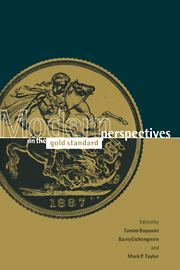Book contents
- Frontmatter
- Contents
- List of figures
- List of tables
- Notes on the contributors
- I Introduction
- II Operation of the gold standard
- III Adjustment mechanisms
- IV Monetary issues
- V Exchange rate behavior
- VI Conclusions
- 13 Déjà vu all over again: lessons from the gold standard for European monetary unification
- Index
13 - Déjà vu all over again: lessons from the gold standard for European monetary unification
Published online by Cambridge University Press: 05 November 2011
- Frontmatter
- Contents
- List of figures
- List of tables
- Notes on the contributors
- I Introduction
- II Operation of the gold standard
- III Adjustment mechanisms
- IV Monetary issues
- V Exchange rate behavior
- VI Conclusions
- 13 Déjà vu all over again: lessons from the gold standard for European monetary unification
- Index
Summary
Historians cannot help but regard the debate over European monetary unification with a sense of déjà vu. The goal is firmly fixed exchange rates between national currencies, the creation of a European Central Bank (ECB) to assume responsibility for the monetary policies of the participating countries, and a single currency for the member states of the European Union. This brave new world resembles nothing so much as the classical gold standard of the 19th century. Under the gold standard the currencies of the leading industrial countries were pegged to one another at stable rates of exchange. Statutory barriers to international flows of financial capital were essentially absent. For this combination of reasons, the monetary autonomy enjoyed by national governments was severely limited. The same will be true over much of Europe assuming the successful completion of European Monetary Union (EMU).
Indeed, the parallels between the two systems extend beyond these technical arrangements. Like today's European Monetary System (EMS), the 19th-century gold standard revolved around the leading European financial power of its time, Great Britain, and its central bank, the Bank of England (for present purposes, the German Bundesbank of its day). Like the prospective EMU, the 19th-century gold standard achieved a high degree of financial and monetary intergration without a matching degree of political centralization.
At the same time, there are limits to the analogy between the gold standard and EMU.
- Type
- Chapter
- Information
- Modern Perspectives on the Gold Standard , pp. 365 - 387Publisher: Cambridge University PressPrint publication year: 1997



